Modeling the Red-Shanked Douc (Pygathrix nemaeus) distribution in Vietnam using Maxent
The Red-shanked Douc (Pygathrix nemaeus) is the only douc species recorded in all three
countries of Indochina. It is classified as Endangered by IUCN, and is believed to have experienced
a major drop of more than 50% of its population over the last 40 years. The known distribution of
main P. nemaeus populations in Vietnam ranges from Pu Mat National Park, Nghe An Province in
the North to the Kon Ha Nung, Gia Lai Province in the South. In this study, we used Maxent, a
species distribution modeling approach that is shown to a have high predictive power even with low
number of occurrence records, to predict the current distribution of the Red-shanked Douc in
Vietnam based on published records. The results show that P. nemaeus inhabits a region from Nghe
An to Kon Tum Province, with areas from Ha Tinh, Quang Binh, Quang Tri, Thua Thien – Hue, Da
Nang – Quang Nam Provinces exhibiting the highest potential. With all model parameters already
listed here, studies in the future may incorporate more occurrence records to develop better models,
or other environmental variables to assess the influence of different factors on the species
distribution. The results also suggest that species distribution modeling, coupled with a carefully
checked and filtered occurrence dataset, as well as species-specific model fine-tuning and
evaluating, can help address many conservation issues in Vietnam.
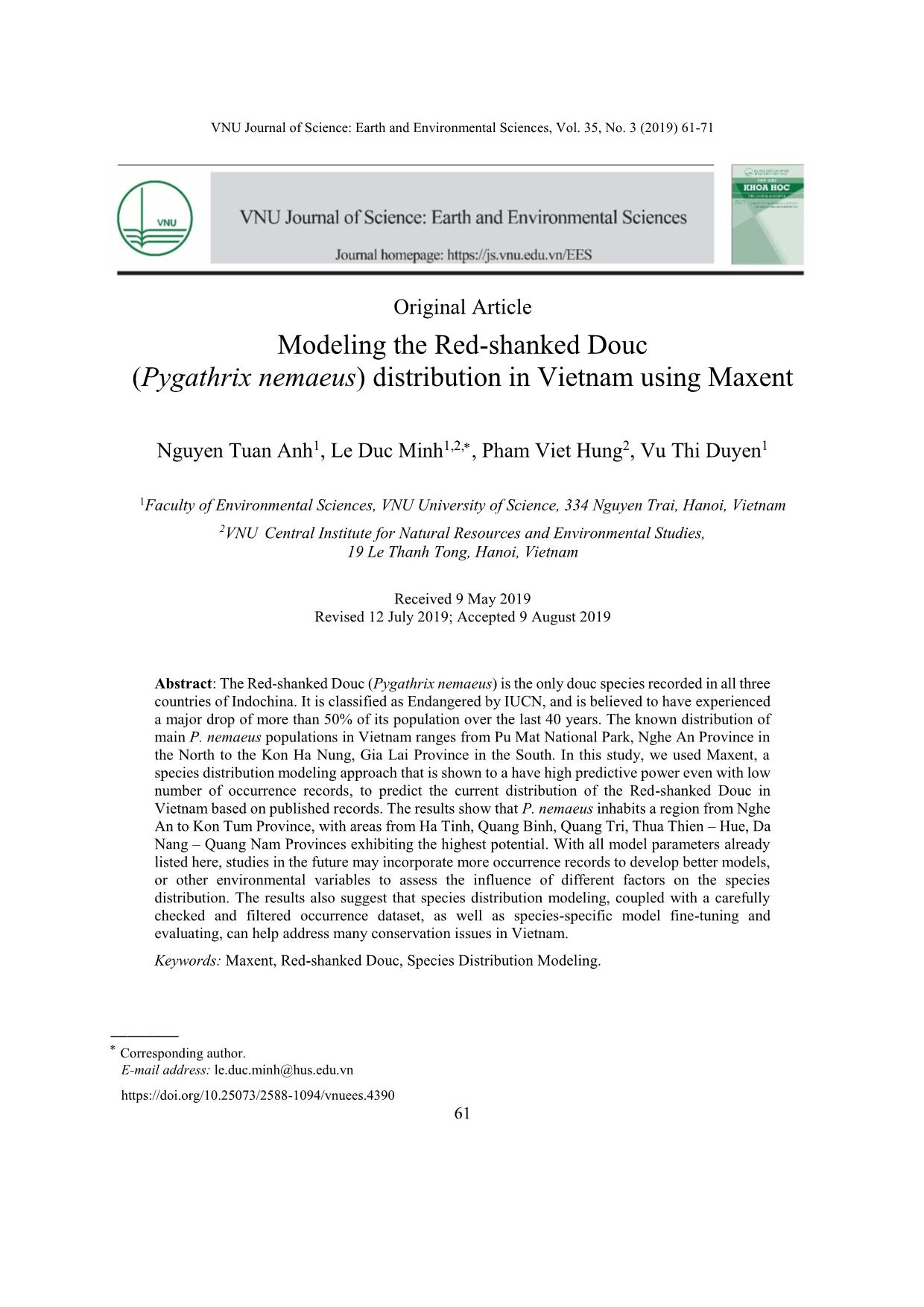
Trang 1
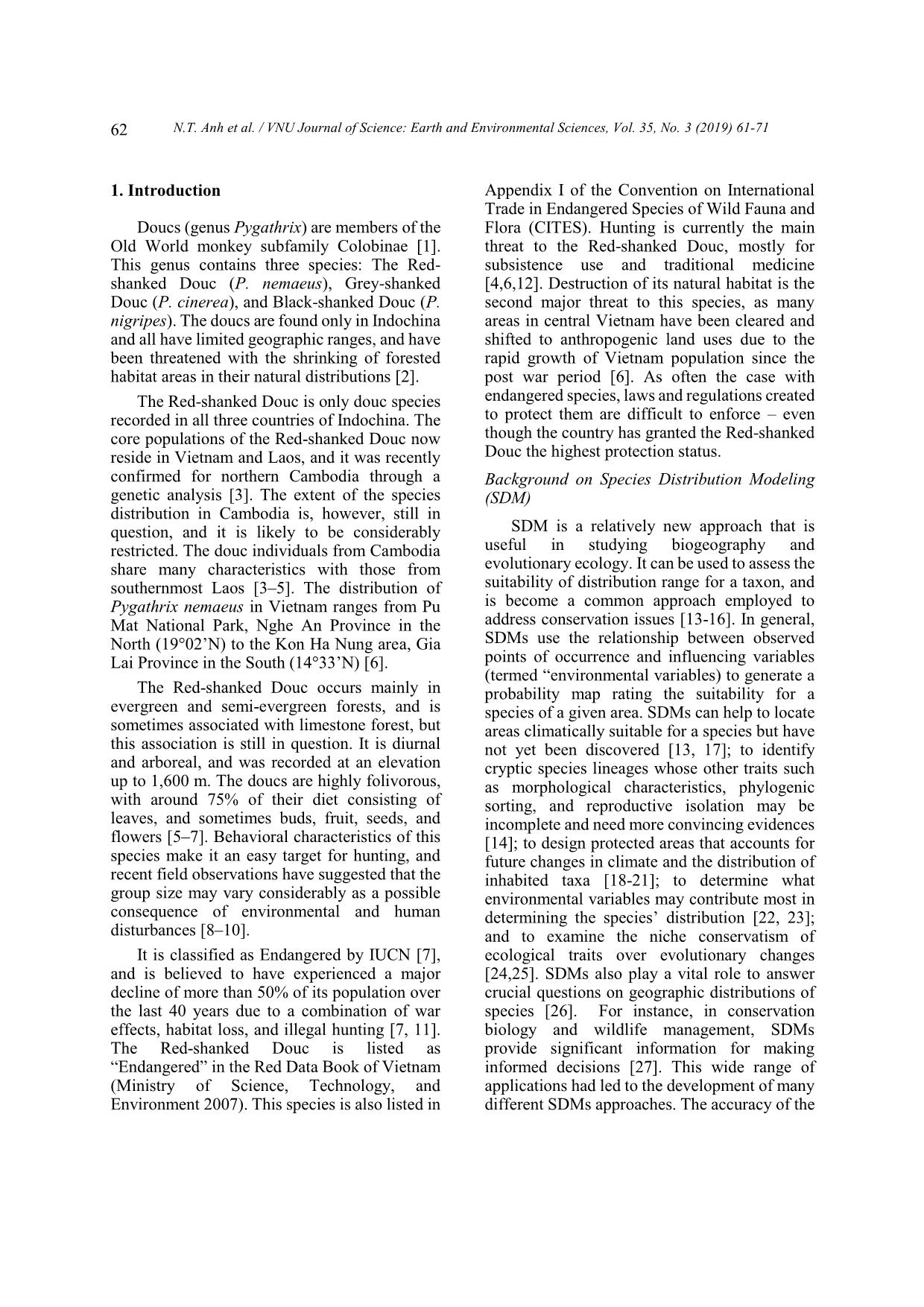
Trang 2
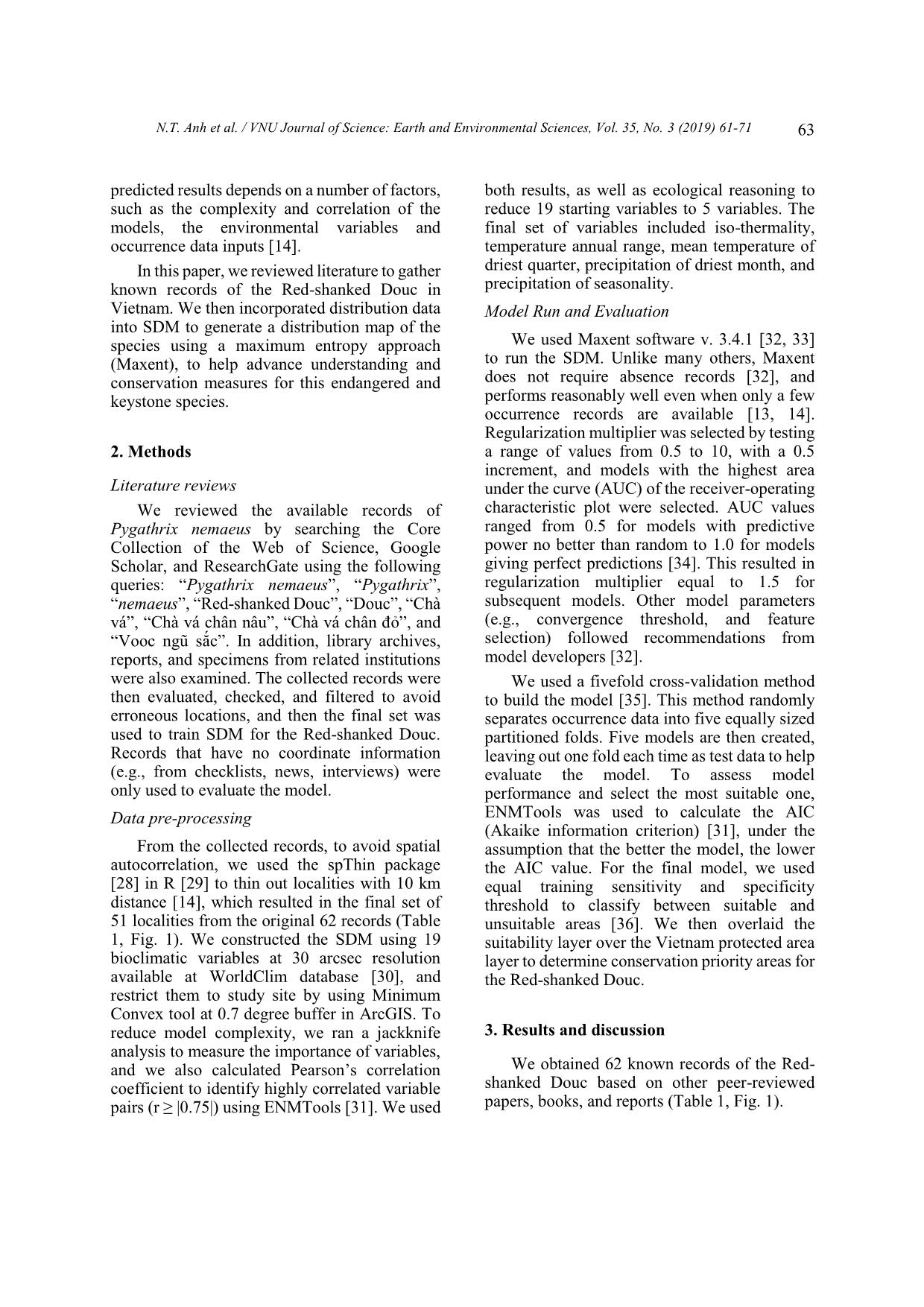
Trang 3
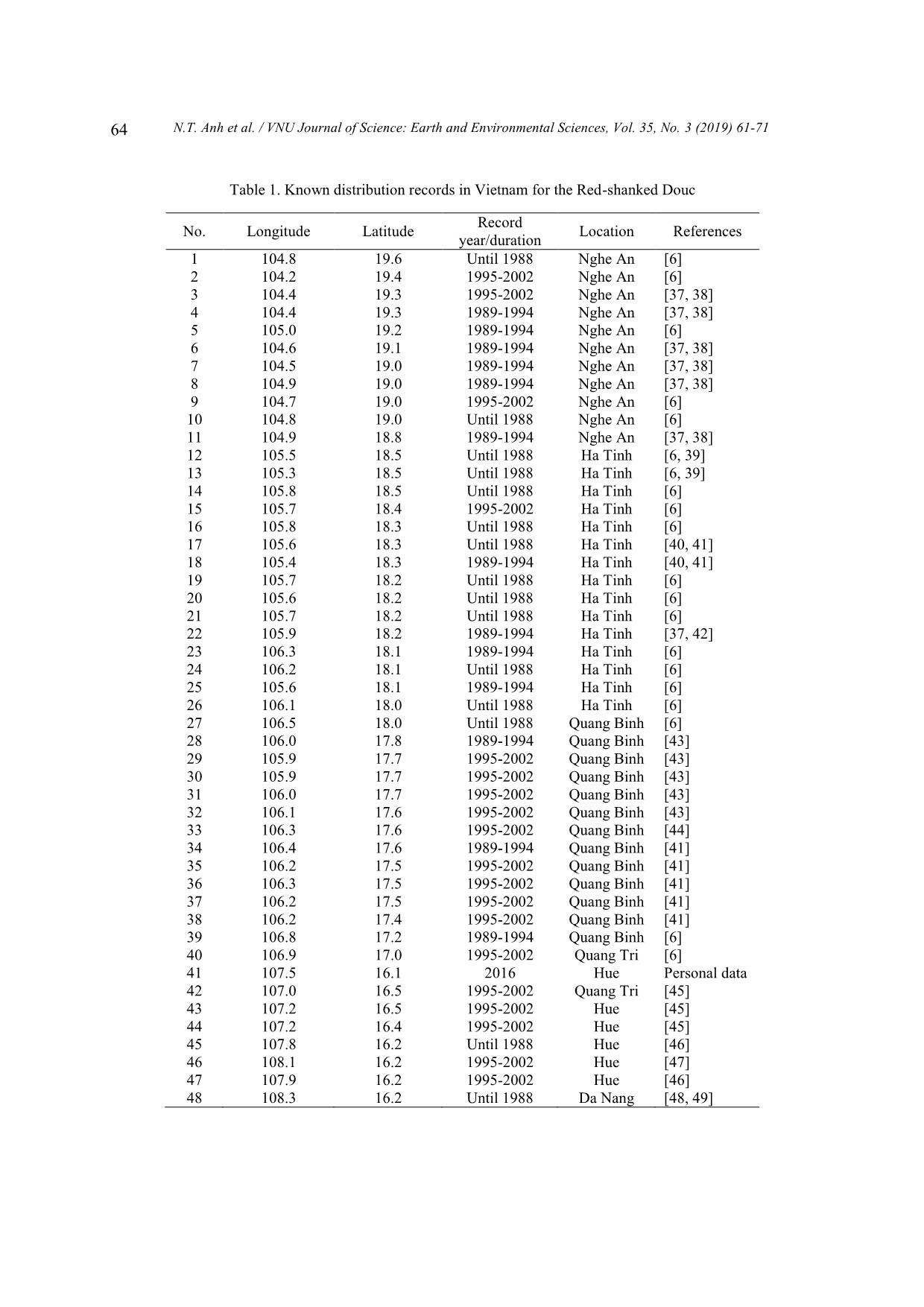
Trang 4
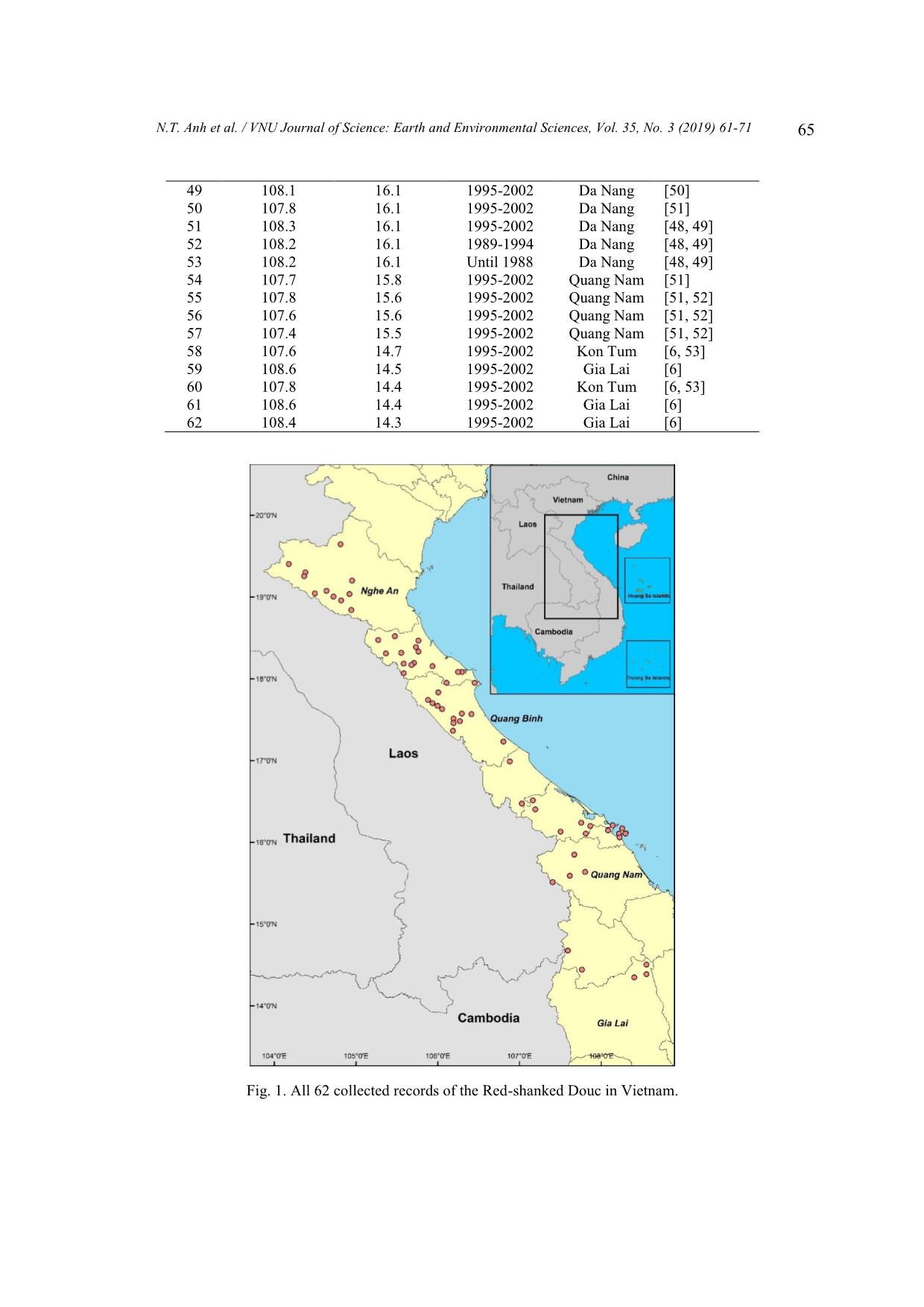
Trang 5
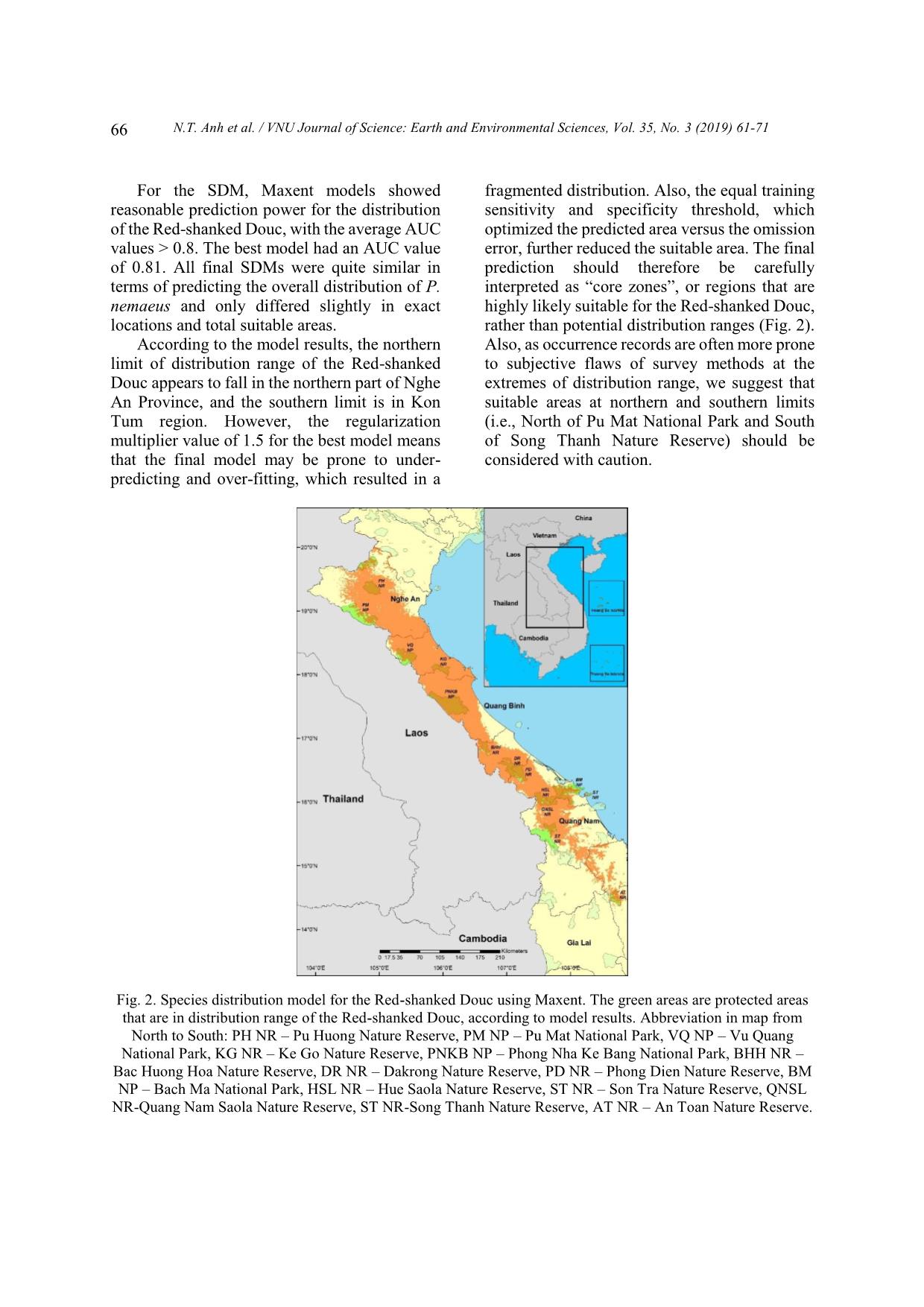
Trang 6
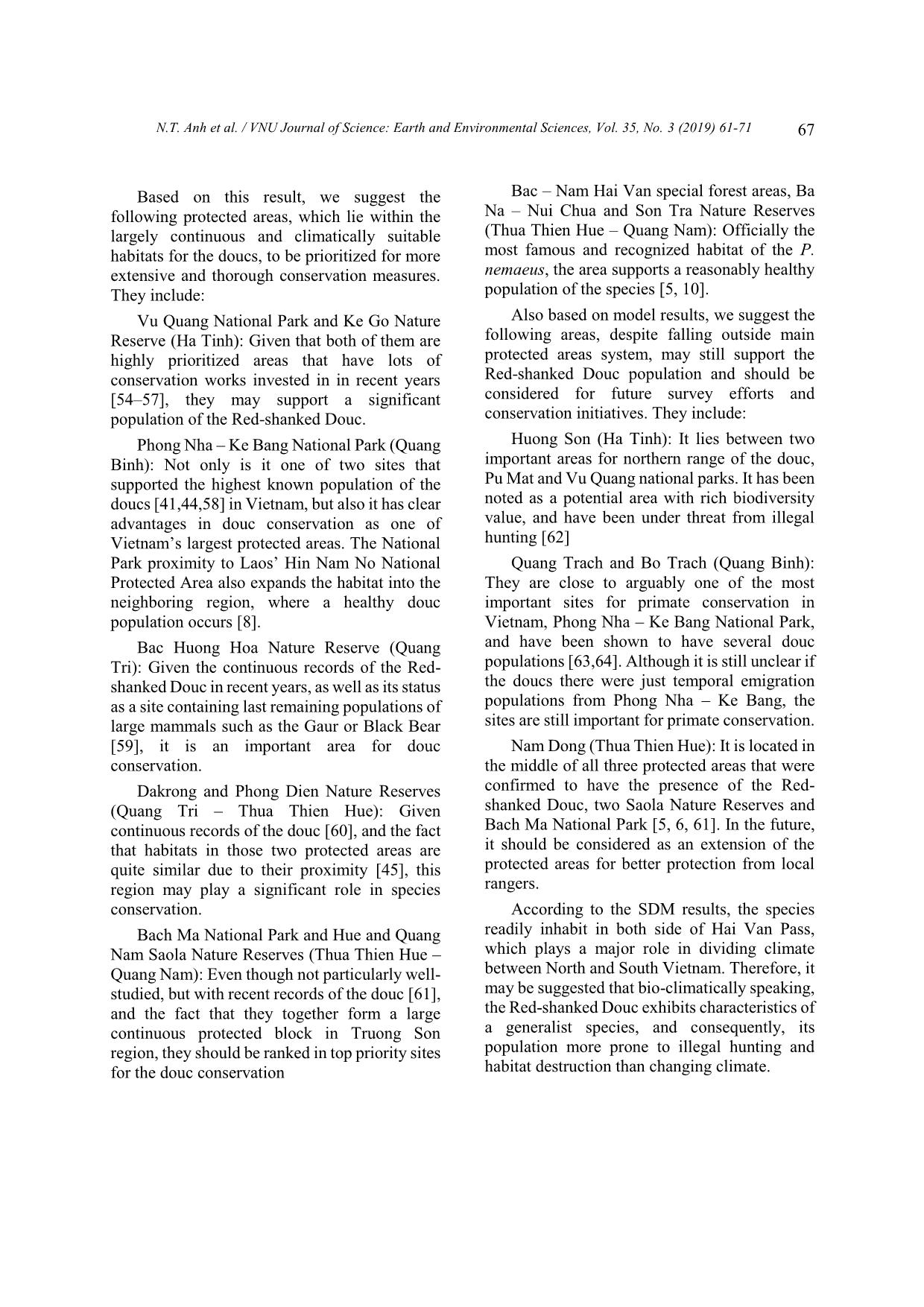
Trang 7
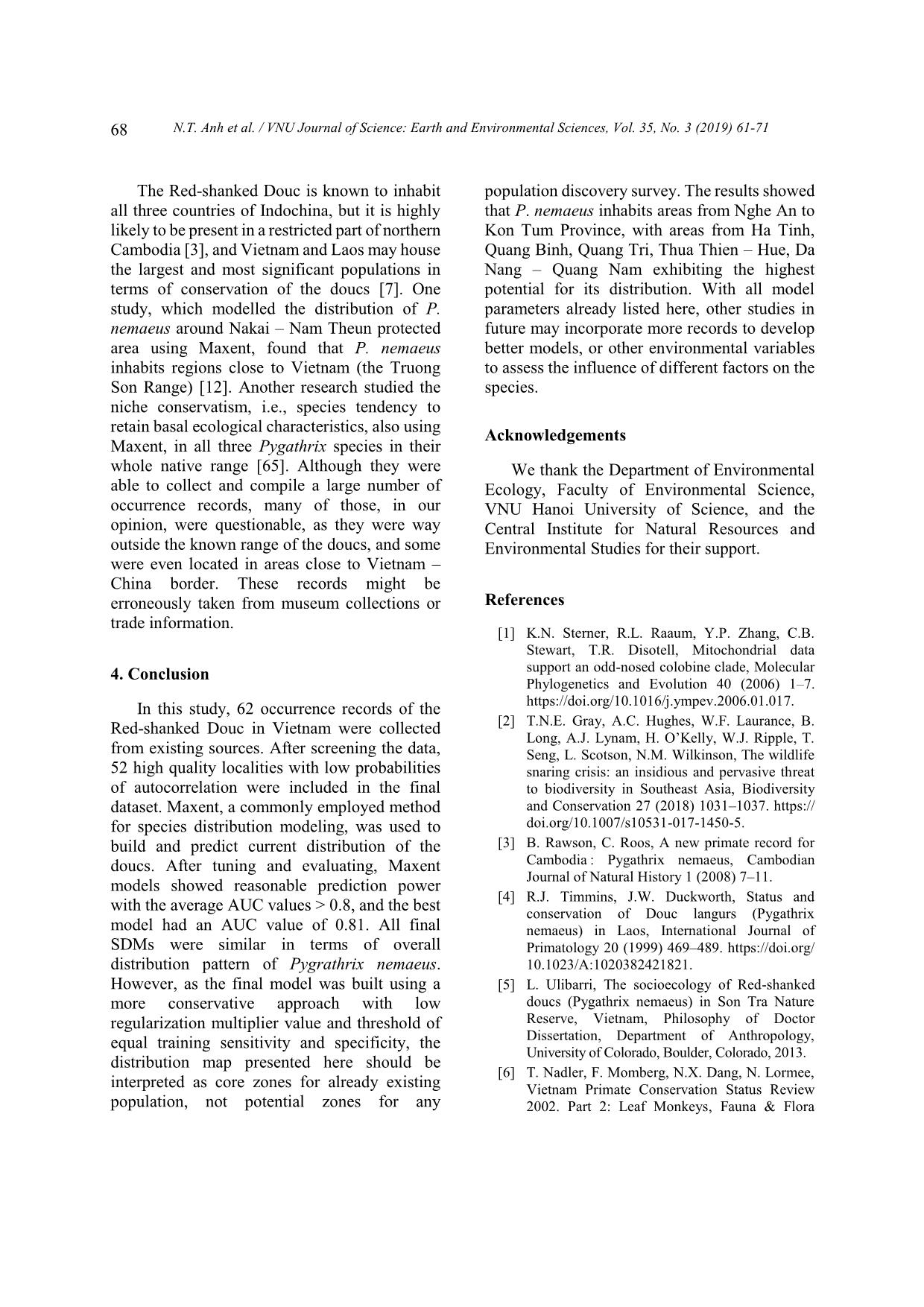
Trang 8
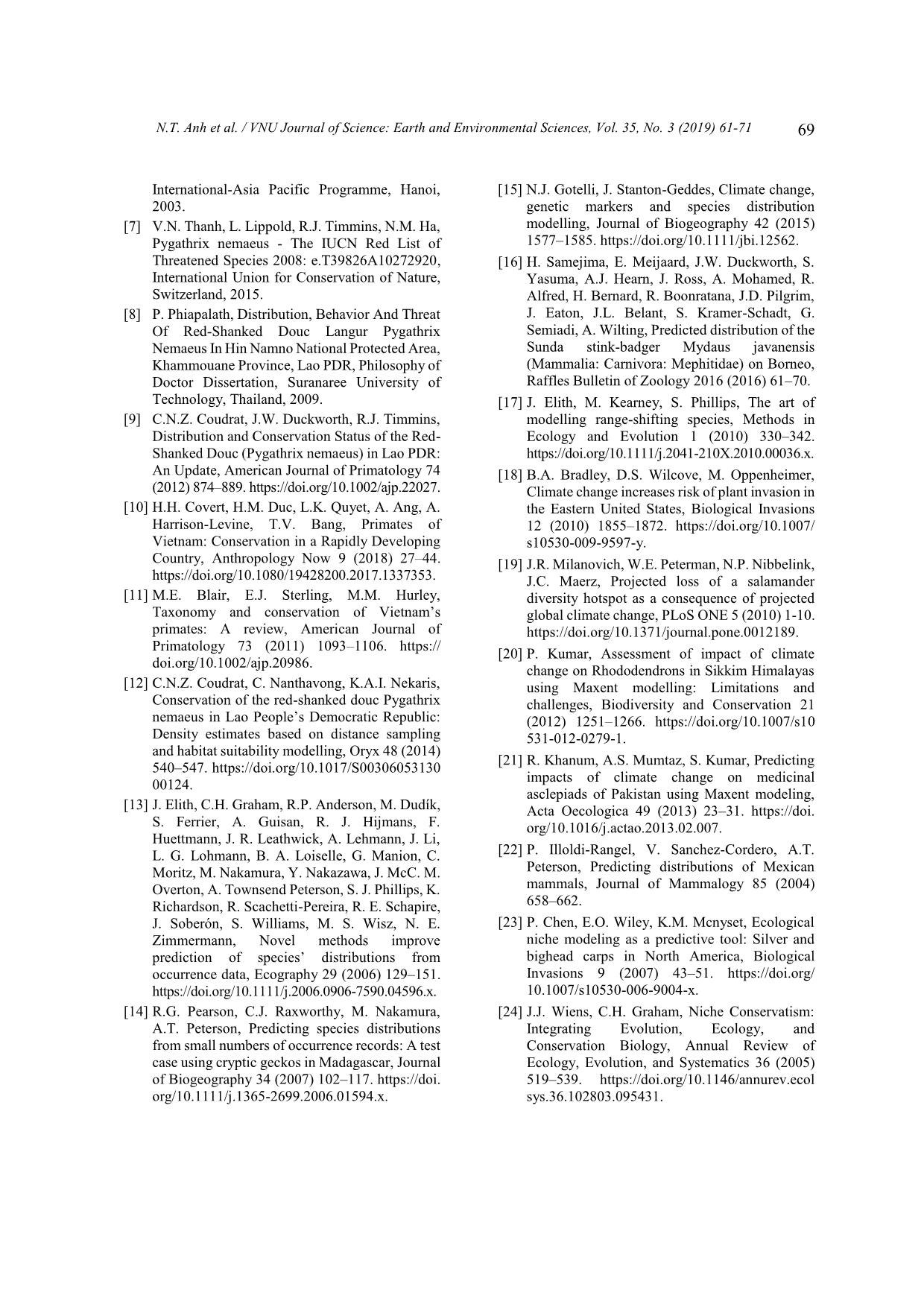
Trang 9
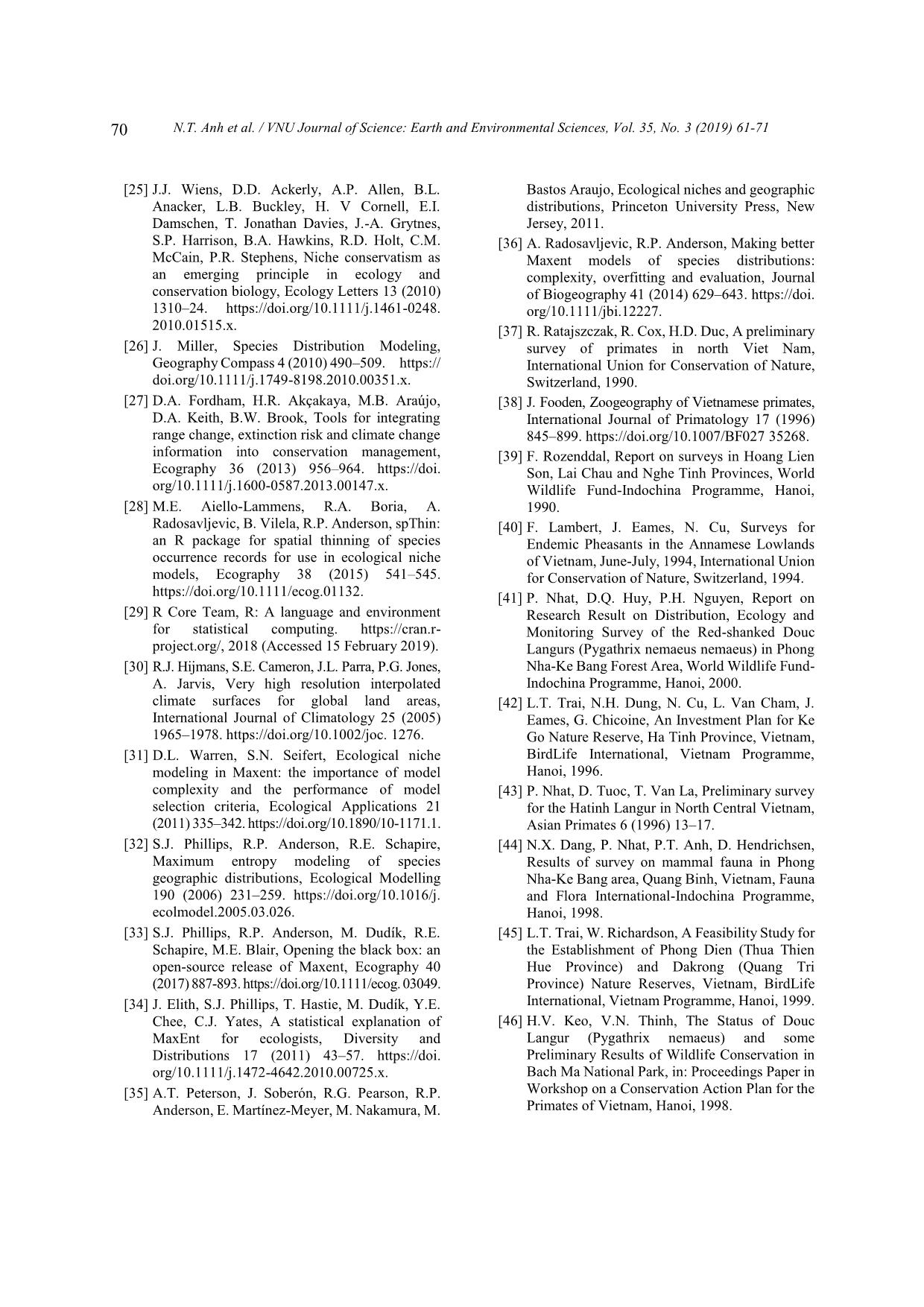
Trang 10
Tải về để xem bản đầy đủ
Tóm tắt nội dung tài liệu: Modeling the Red-Shanked Douc (Pygathrix nemaeus) distribution in Vietnam using Maxent
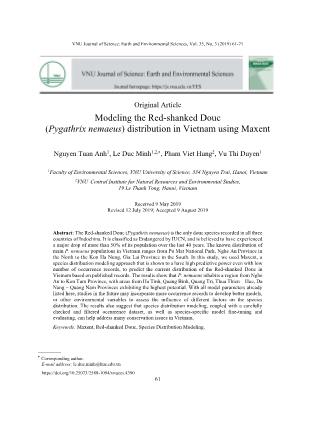
VNU Journal of Science: Earth and Environmental Sciences, Vol. 35, No. 3 (2019) 61-71 61 Original Article Modeling the Red-shanked Douc (Pygathrix nemaeus) distribution in Vietnam using Maxent Nguyen Tuan Anh1, Le Duc Minh1,2, , Pham Viet Hung2, Vu Thi Duyen1 1Faculty of Environmental Sciences, VNU University of Science, 334 Nguyen Trai, Hanoi, Vietnam 2VNU Central Institute for Natural Resources and Environmental Studies, 19 Le Thanh Tong, Hanoi, Vietnam Received 9 May 2019 Revised 12 July 2019; Accepted 9 August 2019 Abstract: The Red-shanked Douc (Pygathrix nemaeus) is the only douc species recorded in all three countries of Indochina. It is classified as Endangered by IUCN, and is believed to have experienced a major drop of more than 50% of its population over the last 40 years. The known distribution of main P. nemaeus populations in Vietnam ranges from Pu Mat National Park, Nghe An Province in the North to the Kon Ha Nung, Gia Lai Province in the South. In this study, we used Maxent, a species distribution modeling approach that is shown to a have high predictive power even with low number of occurrence records, to predict the current distribution of the Red-shanked Douc in Vietnam based on published records. The results show that P. nemaeus inhabits a region from Nghe An to Kon Tum Province, with areas from Ha Tinh, Quang Binh, Quang Tri, Thua Thien – Hue, Da Nang – Quang Nam Provinces exhibiting the highest potential. With all model parameters already listed here, studies in the future may incorporate more occurrence records to develop better models, or other environmental variables to assess the influence of different factors on the species distribution. The results also suggest that species distribution modeling, coupled with a carefully checked and filtered occurrence dataset, as well as species-specific model fine-tuning and evaluating, can help address many conservation issues in Vietnam. Keywords: Maxent, Red-shanked Douc, Species Distribution Modeling. ________ Corresponding author. E-mail address: le.duc.minh@hus.edu.vn https://doi.org/10.25073/2588-1094/vnuees.4390 N.T. Anh et al. / VNU Journal of Science: Earth and Environmental Sciences, Vol. 35, No. 3 (2019) 61-71 62 1. Introduction Doucs (genus Pygathrix) are members of the Old World monkey subfamily Colobinae [1]. This genus contains three species: The Red- shanked Douc (P. nemaeus), Grey-shanked Douc (P. cinerea), and Black-shanked Douc (P. nigripes). The doucs are found only in Indochina and all have limited geographic ranges, and have been threatened with the shrinking of forested habitat areas in their natural distributions [2]. The Red-shanked Douc is only douc species recorded in all three countries of Indochina. The core populations of the Red-shanked Douc now reside in Vietnam and Laos, and it was recently confirmed for northern Cambodia through a genetic analysis [3]. The extent of the species distribution in Cambodia is, however, still in question, and it is likely to be considerably restricted. The douc individuals from Cambodia share many characteristics with those from southernmost Laos [3–5]. The distribution of Pygathrix nemaeus in Vietnam ranges from Pu Mat National Park, Nghe An Province in the North (19°02’N) to the Kon Ha Nung area, Gia Lai Province in the South (14°33’N) [6]. The Red-shanked Douc occurs mainly in evergreen and semi-evergreen forests, and is sometimes associated with limestone forest, but this association is still in question. It is diurnal and arboreal, and was recorded at an elevation up to 1,600 m. The doucs are highly folivorous, with around 75% of their diet consisting of leaves, and sometimes buds, fruit, seeds, and flowers [5–7]. Behavioral characteristics of this species make it an easy target for hunting, and recent field observations have suggested that the group size may vary considerably as a possible consequence of environmental and human disturbances [8–10]. It is classified as Endangered by IUCN [7], and is believed to have experienced a major decline of more than 50% of its population over the last 40 years due to a combination of war effects, habitat loss, and illegal hunting [7, 11]. The Red-shanked Douc is listed as “Endangered” in the Red Data Book of Vietnam (Ministry of Science, Technology, and Environment 2007). This species is also listed in Appendix I of the Convention on International Trade in Endangered Species of Wild Fauna and Flora (CITES). Hunting is currently the main threat to the Red-shanked Douc, mostly for subsistence use and traditional medicine [4,6,12]. Destruction of its natural habitat is the second major threat to this species, as many areas in central Vietnam have been cleared and shifted to anthropogenic land uses due to the rapid growth of Vietnam population since the post war period [6]. As often the case with endangered species, laws and regulations created to protect them are difficult to enforce – even though the country has granted the Red-shanked Douc the highest protection status. Background on Species Distribution Modeling (SDM) SDM is a relatively new approach that is useful in studying biogeography and evolutionary ecology. It can be used to assess the suitability of distribution range for a taxon, and is become a common approach employed to address conservation issues [13-16]. In general, SDMs use the relationship between observed points of occurrence and influencing variables (termed “environmental variables) to generate a probability map rating the suitability for a species of a given area. SDMs can help to locate areas climatically suitable for a species but have not yet been discovered [13, 17]; to identify cryptic species lineages whose other traits such as morphological characteristics, phylogenic ... .org/ 10.1023/A:1020382421821. [5] L. Ulibarri, The socioecology of Red-shanked doucs (Pygathrix nemaeus) in Son Tra Nature Reserve, Vietnam, Philosophy of Doctor Dissertation, Department of Anthropology, University of Colorado, Boulder, Colorado, 2013. [6] T. Nadler, F. Momberg, N.X. Dang, N. Lormee, Vietnam Primate Conservation Status Review 2002. Part 2: Leaf Monkeys, Fauna & Flora N.T. Anh et al. / VNU Journal of Science: Earth and Environmental Sciences, Vol. 35, No. 3 (2019) 61-71 69 International-Asia Pacific Programme, Hanoi, 2003. [7] V.N. Thanh, L. Lippold, R.J. Timmins, N.M. Ha, Pygathrix nemaeus - The IUCN Red List of Threatened Species 2008: e.T39826A10272920, International Union for Conservation of Nature, Switzerland, 2015. [8] P. Phiapalath, Distribution, Behavior And Threat Of Red-Shanked Douc Langur Pygathrix Nemaeus In Hin Namno National Protected Area, Khammouane Province, Lao PDR, Philosophy of Doctor Dissertation, Suranaree University of Technology, Thailand, 2009. [9] C.N.Z. Coudrat, J.W. Duckworth, R.J. Timmins, Distribution and Conservation Status of the Red- Shanked Douc (Pygathrix nemaeus) in Lao PDR: An Update, American Journal of Primatology 74 (2012) 874–889. https://doi.org/10.1002/ajp.22027. [10] H.H. Covert, H.M. Duc, L.K. Quyet, A. Ang, A. Harrison-Levine, T.V. Bang, Primates of Vietnam: Conservation in a Rapidly Developing Country, Anthropology Now 9 (2018) 27–44. https://doi.org/10.1080/19428200.2017.1337353. [11] M.E. Blair, E.J. Sterling, M.M. Hurley, Taxonomy and conservation of Vietnam’s primates: A review, American Journal of Primatology 73 (2011) 1093–1106. https:// doi.org/10.1002/ajp.20986. [12] C.N.Z. Coudrat, C. Nanthavong, K.A.I. Nekaris, Conservation of the red-shanked douc Pygathrix nemaeus in Lao People’s Democratic Republic: Density estimates based on distance sampling and habitat suitability modelling, Oryx 48 (2014) 540–547. https://doi.org/10.1017/S00306053130 00124. [13] J. Elith, C.H. Graham, R.P. Anderson, M. Dudík, S. Ferrier, A. Guisan, R. J. Hijmans, F. Huettmann, J. R. Leathwick, A. Lehmann, J. Li, L. G. Lohmann, B. A. Loiselle, G. Manion, C. Moritz, M. Nakamura, Y. Nakazawa, J. McC. M. Overton, A. Townsend Peterson, S. J. Phillips, K. Richardson, R. Scachetti-Pereira, R. E. Schapire, J. Soberón, S. Williams, M. S. Wisz, N. E. Zimmermann, Novel methods improve prediction of species’ distributions from occurrence data, Ecography 29 (2006) 129–151. https://doi.org/10.1111/j.2006.0906-7590.04596.x. [14] R.G. Pearson, C.J. Raxworthy, M. Nakamura, A.T. Peterson, Predicting species distributions from small numbers of occurrence records: A test case using cryptic geckos in Madagascar, Journal of Biogeography 34 (2007) 102–117. https://doi. org/10.1111/j.1365-2699.2006.01594.x. [15] N.J. Gotelli, J. Stanton-Geddes, Climate change, genetic markers and species distribution modelling, Journal of Biogeography 42 (2015) 1577–1585. https://doi.org/10.1111/jbi.12562. [16] H. Samejima, E. Meijaard, J.W. Duckworth, S. Yasuma, A.J. Hearn, J. Ross, A. Mohamed, R. Alfred, H. Bernard, R. Boonratana, J.D. Pilgrim, J. Eaton, J.L. Belant, S. Kramer-Schadt, G. Semiadi, A. Wilting, Predicted distribution of the Sunda stink-badger Mydaus javanensis (Mammalia: Carnivora: Mephitidae) on Borneo, Raffles Bulletin of Zoology 2016 (2016) 61–70. [17] J. Elith, M. Kearney, S. Phillips, The art of modelling range-shifting species, Methods in Ecology and Evolution 1 (2010) 330–342. https://doi.org/10.1111/j.2041-210X.2010.00036.x. [18] B.A. Bradley, D.S. Wilcove, M. Oppenheimer, Climate change increases risk of plant invasion in the Eastern United States, Biological Invasions 12 (2010) 1855–1872. https://doi.org/10.1007/ s10530-009-9597-y. [19] J.R. Milanovich, W.E. Peterman, N.P. Nibbelink, J.C. Maerz, Projected loss of a salamander diversity hotspot as a consequence of projected global climate change, PLoS ONE 5 (2010) 1-10. https://doi.org/10.1371/journal.pone.0012189. [20] P. Kumar, Assessment of impact of climate change on Rhododendrons in Sikkim Himalayas using Maxent modelling: Limitations and challenges, Biodiversity and Conservation 21 (2012) 1251–1266. https://doi.org/10.1007/s10 531-012-0279-1. [21] R. Khanum, A.S. Mumtaz, S. Kumar, Predicting impacts of climate change on medicinal asclepiads of Pakistan using Maxent modeling, Acta Oecologica 49 (2013) 23–31. https://doi. org/10.1016/j.actao.2013.02.007. [22] P. Illoldi-Rangel, V. Sanchez-Cordero, A.T. Peterson, Predicting distributions of Mexican mammals, Journal of Mammalogy 85 (2004) 658–662. [23] P. Chen, E.O. Wiley, K.M. Mcnyset, Ecological niche modeling as a predictive tool: Silver and bighead carps in North America, Biological Invasions 9 (2007) 43–51. https://doi.org/ 10.1007/s10530-006-9004-x. [24] J.J. Wiens, C.H. Graham, Niche Conservatism: Integrating Evolution, Ecology, and Conservation Biology, Annual Review of Ecology, Evolution, and Systematics 36 (2005) 519–539. https://doi.org/10.1146/annurev.ecol sys.36.102803.095431. N.T. Anh et al. / VNU Journal of Science: Earth and Environmental Sciences, Vol. 35, No. 3 (2019) 61-71 70 [25] J.J. Wiens, D.D. Ackerly, A.P. Allen, B.L. Anacker, L.B. Buckley, H. V Cornell, E.I. Damschen, T. Jonathan Davies, J.-A. Grytnes, S.P. Harrison, B.A. Hawkins, R.D. Holt, C.M. McCain, P.R. Stephens, Niche conservatism as an emerging principle in ecology and conservation biology, Ecology Letters 13 (2010) 1310–24. https://doi.org/10.1111/j.1461-0248. 2010.01515.x. [26] J. Miller, Species Distribution Modeling, Geography Compass 4 (2010) 490–509. https:// doi.org/10.1111/j.1749-8198.2010.00351.x. [27] D.A. Fordham, H.R. Akçakaya, M.B. Araújo, D.A. Keith, B.W. Brook, Tools for integrating range change, extinction risk and climate change information into conservation management, Ecography 36 (2013) 956–964. https://doi. org/10.1111/j.1600-0587.2013.00147.x. [28] M.E. Aiello-Lammens, R.A. Boria, A. Radosavljevic, B. Vilela, R.P. Anderson, spThin: an R package for spatial thinning of species occurrence records for use in ecological niche models, Ecography 38 (2015) 541–545. https://doi.org/10.1111/ecog.01132. [29] R Core Team, R: A language and environment for statistical computing. https://cran.r- project.org/, 2018 (Accessed 15 February 2019). [30] R.J. Hijmans, S.E. Cameron, J.L. Parra, P.G. Jones, A. Jarvis, Very high resolution interpolated climate surfaces for global land areas, International Journal of Climatology 25 (2005) 1965–1978. https://doi.org/10.1002/joc. 1276. [31] D.L. Warren, S.N. Seifert, Ecological niche modeling in Maxent: the importance of model complexity and the performance of model selection criteria, Ecological Applications 21 (2011) 335–342. https://doi.org/10.1890/10-1171.1. [32] S.J. Phillips, R.P. Anderson, R.E. Schapire, Maximum entropy modeling of species geographic distributions, Ecological Modelling 190 (2006) 231–259. https://doi.org/10.1016/j. ecolmodel.2005.03.026. [33] S.J. Phillips, R.P. Anderson, M. Dudík, R.E. Schapire, M.E. Blair, Opening the black box: an open-source release of Maxent, Ecography 40 (2017) 887-893. https://doi.org/10.1111/ecog. 03049. [34] J. Elith, S.J. Phillips, T. Hastie, M. Dudík, Y.E. Chee, C.J. Yates, A statistical explanation of MaxEnt for ecologists, Diversity and Distributions 17 (2011) 43–57. https://doi. org/10.1111/j.1472-4642.2010.00725.x. [35] A.T. Peterson, J. Soberón, R.G. Pearson, R.P. Anderson, E. Martínez-Meyer, M. Nakamura, M. Bastos Araujo, Ecological niches and geographic distributions, Princeton University Press, New Jersey, 2011. [36] A. Radosavljevic, R.P. Anderson, Making better Maxent models of species distributions: complexity, overfitting and evaluation, Journal of Biogeography 41 (2014) 629–643. https://doi. org/10.1111/jbi.12227. [37] R. Ratajszczak, R. Cox, H.D. Duc, A preliminary survey of primates in north Viet Nam, International Union for Conservation of Nature, Switzerland, 1990. [38] J. Fooden, Zoogeography of Vietnamese primates, International Journal of Primatology 17 (1996) 845–899. https://doi.org/10.1007/BF027 35268. [39] F. Rozenddal, Report on surveys in Hoang Lien Son, Lai Chau and Nghe Tinh Provinces, World Wildlife Fund-Indochina Programme, Hanoi, 1990. [40] F. Lambert, J. Eames, N. Cu, Surveys for Endemic Pheasants in the Annamese Lowlands of Vietnam, June-July, 1994, International Union for Conservation of Nature, Switzerland, 1994. [41] P. Nhat, D.Q. Huy, P.H. Nguyen, Report on Research Result on Distribution, Ecology and Monitoring Survey of the Red-shanked Douc Langurs (Pygathrix nemaeus nemaeus) in Phong Nha-Ke Bang Forest Area, World Wildlife Fund- Indochina Programme, Hanoi, 2000. [42] L.T. Trai, N.H. Dung, N. Cu, L. Van Cham, J. Eames, G. Chicoine, An Investment Plan for Ke Go Nature Reserve, Ha Tinh Province, Vietnam, BirdLife International, Vietnam Programme, Hanoi, 1996. [43] P. Nhat, D. Tuoc, T. Van La, Preliminary survey for the Hatinh Langur in North Central Vietnam, Asian Primates 6 (1996) 13–17. [44] N.X. Dang, P. Nhat, P.T. Anh, D. Hendrichsen, Results of survey on mammal fauna in Phong Nha-Ke Bang area, Quang Binh, Vietnam, Fauna and Flora International-Indochina Programme, Hanoi, 1998. [45] L.T. Trai, W. Richardson, A Feasibility Study for the Establishment of Phong Dien (Thua Thien Hue Province) and Dakrong (Quang Tri Province) Nature Reserves, Vietnam, BirdLife International, Vietnam Programme, Hanoi, 1999. [46] H.V. Keo, V.N. Thinh, The Status of Douc Langur (Pygathrix nemaeus) and some Preliminary Results of Wildlife Conservation in Bach Ma National Park, in: Proceedings Paper in Workshop on a Conservation Action Plan for the Primates of Vietnam, Hanoi, 1998. N.T. Anh et al. / VNU Journal of Science: Earth and Environmental Sciences, Vol. 35, No. 3 (2019) 61-71 71 [47] W. Osgood, Mammals of the Kelley-Roosevelts and Delacour Asiatic expeditions, Field Museum of Natural History, Zoological Series 18 (1932) 193–339. [48] P. Nhat, Preliminary results on the diet of the Red-shanked douc langur (Pygathrix nemaeus), Asian Primates 4 (1994) 9–11. [49] L. Lippold, Distribution and conservation status of Douc langurs in Vietnam, Asian Primates 4 (1995) 4–6. [50] Anon., Feasibility Study for Ba Na Nui Chua, Quang Nam-Da Nang Province, Ministry of Forestry, Hanoi, 1994. [51] H.T. Long, Douc langur Survey in Central and South Vietnam - May to July and October 2000, Frankfurt Zoological Society, Frankfurt, 2000. [52] E. Wikramanayake, V.V. Dung, P.M. Giao, A Biological and Socio-economic Survey of West Quang Nam Province with Recommendations for a Nature Reserve, World Wildlife Fund- Indochina Programme, Hanoi, 1997. [53] D. Tuoc, Features and Values of Fauna Component of the Chu Mom Ray Nature Reserve, Forest Inventory and Planning Institute, Hanoi, 1995. [54] V.V. Dung, N.N. Chinh, D. Tuoc, P.M. Giao, J. MacKinnon, Discovery and conservation of the Vu Quang ox in Vietnam, Oryx 28 (1994) 16–21. https://doi.org/10.1017/S0030605300028246. [55] N. Kemp, M. Dilger, N. Burgess, C.V. Dung, The saola Pseudoryx nghetinhensis in Vietnam - New information on distribution and habitat preferences, and conservation needs, Oryx 31 (1997) 37–44. https://doi.org/10.1046/j.1365- 3008.1997.d01-86.x. [56] D.P. Lunde, G.G. Musser, T. Ziegler, Description of a new species of Crocidura (Soricomorpha: Soricidae, Crocidurinae) from Ke Go Nature Reserve, Vietnam, Mammal Study 29 (2007) 27– 36. https://doi.org/10.3106/mammalstudy.29.27. [57] D. Willcox, T.Q. Phuong, N.V. Thai, N.V. Nhuan, J. Kempinski, S. Roberton, The conservation status of small carnivores in the Ke Go – Khe Net Lowlands, Central Vietnam, Small Carnivore Conservation 52&53 (2015) 56–73. [58] T. Haus, M. Vogt, B. Forster, N.T. Vu, T. Ziegler, Distribution and population densities of diurnal primates in the Karst Forests of Phong Nha - Ke Bang National Park, Quang Binh Province, Central Vietnam, International Journal of Primatology 30 (2009) 301–312. https://doi.org /10.1007/s10764-009-9343-4. [59] S. Mahood, T.V. Hung, The Biodiversity of Bac Huong Hoa Nature Reserve, Quang Tri Province, Vietnam, BirdLife International-Vietnam Programme, Hanoi, 2008. [60] N.D. Manh, N.X. Dang, N.X. Nghia, Conservation importance of mammal fauna in Dakrong Nature Reserve, Quang Tri Province, Journal of Biology 31 (2009) 42–50. [61] Anon., Basic Information about Hue Saola Nature Reserve, Hue Department of Forest Protection, Hue, 2013. [62] R.J. Timmins, T.V. Cuong, An assessment of the conservation importance of the Huong Son (Annamite) Forest, Ha Tinh Province,Vietnam, based on the results of a field survey for large mammals and birds, Center for Biodiversity and Conservation, at American Museum of Natural History, Hanoi, 2001. [63] T.D. Le, T. Do, H.T. Dinh, T.D. Le, N.K. Dang, Census of Southern White-Cheeked Crested Gibbons in U Bo and Adjacent Bufferzone Forests, Phong Nha-Ke Bang National, Fauna and Flora International-Indochina Programme, Hanoi, 2009. [64] Frankfurt Zoological Society, Biodiversity Survey of Macaque, Langur and Douc monkey in and around the Phong Nha - Ke Bang National Park, Quang Binh, Viet Nam, Frankfurt Zoological Society, Frankfurt, 2011. [65] N.N. Bett, M.E. Blair, E.J. Sterling, Ecological Niche Conservatism in Doucs (Genus Pygathrix), International Journal of Primatology 33 (2012) 972 -988. https://doi.org/10.1007/s10764-012-9622-3.
File đính kèm:
 modeling_the_red_shanked_douc_pygathrix_nemaeus_distribution.pdf
modeling_the_red_shanked_douc_pygathrix_nemaeus_distribution.pdf

